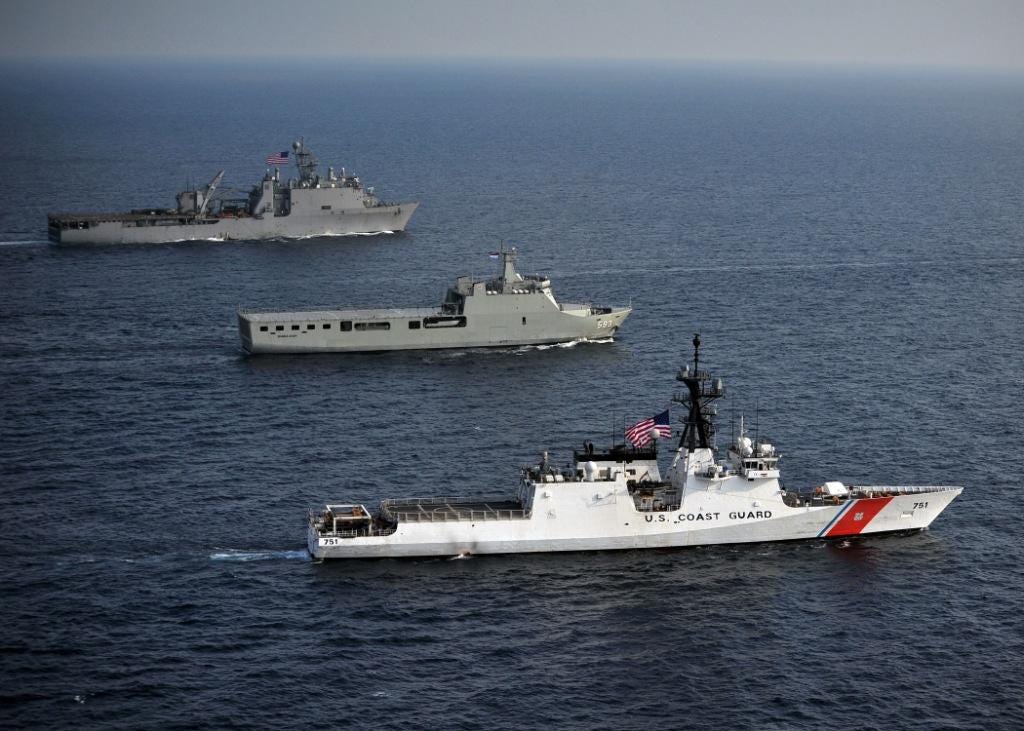
The Pentagon’s controversial 2015 budget proposal calls for some big changes in what kinds of weapons the U.S. military buys. Among other reforms, Secretary of Defense Chuck Hagel wants the Navy to stop building lightly armed Littoral Combat Ships and replace them with a new, more deadly small warship—a frigate, one able to fight and survive in even the most dangerous waters.
Perhaps anticipating the shipbuilding reversal, the American arms industry has already prepared new warship designs that could fit the bill. They include a beefed-up version of the existing LCS and a modified Coast Guard patrol ship with extra weapons.
For years, the Navy planned to buy at least 52 of the 3,000-ton Littoral Combat Ships to make up a large portion of the Navy’s future surface fleet alongside 9,000-ton Arleigh Burke-class destroyers. Cost and a new warfare concept were the major motivators.
A single LCS costs around $600 million—just a quarter the price of a newBurke. The two LCS types—one each built by Lockheed Martin and Austal—are both minimally armed with just a 57-millimeter gun and a couple dozen short-range missiles, compared to nearly 100 big, long-range missiles and a 127-millimeter gun on a Burke.
According to the Navy, the 400-foot-long LCS will use its high speed—45 knots compared to the Burke’s 30 knots—to escape danger. It will send its two helicopters plus drones to find and attack enemy forces.

But critics doubt the value of speed and fret over the LCS’s lightweight aluminum construction and lack of heavy armament—especially for operations near Chinese waters, which teem with warships from a dozen countries.
Hagel is equally worried. “I am concerned that the Navy is relying too heavily on the LCS to achieve its long-term goals for ship numbers,” he explained in his 2015 budget justification, leaked to the press on Feb. 24. “We need to closely examine whether the LCS has the protection and firepower to survive.”
“Therefore, no new contract negotiations beyond 32 ships will go forward,” Hagel added.
That leaves the Navy with a two-dozen-ship gap in its force structure—one Hagel intends to fill with a more powerful combatant. “The Navy will submit alternative proposals to procure a capable and lethal small surface combatant, consistent with the capabilities of a frigate,” he said. “I’ve directed the Navy to consider a completely new design, existing ship designs and a modified LCS.”
A number of American and foreign shipbuilders could submit new designs. There are also several existing foreign ship types that could fit the bill, including the German MEKO frigate, France’s Gowind or the British Type 26. Europe’s navies tend to prefer frigates over the larger, more expensive destroyers that dominate the U.S. fleet.
If the Pentagon selects a foreign vessel, the new ship will almost certainly still have to be built in America by American workers, as is the case with the LCS made in Alabama by Austal, an Australian company.
If the Navy prefers an existing American design—and it surely does, for reasons of cost and political convenience—there’s really just one choice: Huntington Ingalls’ National Patrol Frigate, a proposed variant of the shipbuilder’s Coast Guard National Security Cutter.
The Coast Guard is getting up to eight of the 4,500-ton NSCs for open-ocean patrols. More than 400 feet long with a large flight deck, the steel NSCs feature the same 57-millimeter gun as the LCS plus a 20-millimeter defense gun for what is, in essence, a law-enforcement mission.
The patrol frigate version retains the NSC’s hull and powerplant but replaces the small gun with a more powerful 76-millimeter model and also adds 12 vertical missile cells for long-range air-defense and cruise missiles plus quad Harpoon anti-ship missile launchers and torpedo tubes—making the patrol frigate far deadlier than the LCS.
But slower. The LSC can top 40 knots, but NSC practically putters along at just 28 knots. But the slower ship is more efficient. The LCS can sail around 5,000 miles before needing to refuel. The NSC can go 12,000 miles.
It’s unclear how much Huntington Ingalls’ patrol frigate might cost. The Coast Guard has paid around $700 million for each of its NSCs. The Navy version could be more expensive because of all the added equipment—but on the other hand, the Navy will buy more of them. Economies of scale could drive down the average cost.

If the Navy decides on a modified LCS instead of a new design or the patrol frigate, it could opt for Lockheed’s export version of the littoral combatant. In 2008, Lockheed pitched this design to Israel, but the Jewish state opted for a cheaper German-made frigate, instead.
The proposed LCS-Israel is a much harder-hitting ship than the standard LCS. It has an extra 16 vertical missile cells, Harpoon anti-ship missiles, a 20-millimeter defense gun and torpedoes. Six years ago, Lockheed offered LCS-I to Tel Aviv for around $500 million per copy—the price is surely higher now.
While more heavily armed than the American LCS, the export version of the vessel has the same hull and powerplant—meaning it’s fast and flimsy compared to Huntington Ingalls’ slower and arguably tougher patrol frigate.
What the Navy decides could reflect its philosophy. Given ships with roughly equal armament, does the sailing branch prefer speed and lightness or endurance and toughness?
We know what Hagel prefers. Barring selection of a brand-new design, that points to Huntington Ingalls’ patrol frigate as the likely choice.War is Boring
No comments:
Post a Comment